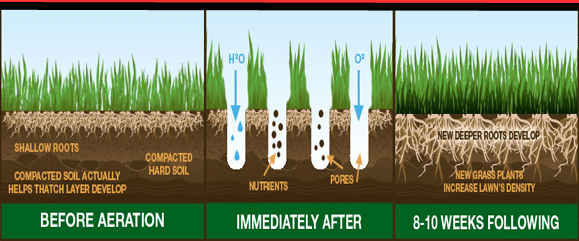3rd in a 3-part Series on Controlling Lawn Weeds Organically
Good fall lawn care sets your lawn up to be its healthiest next spring. Growing thick, dense grass is your best offense and defense in naturally crowding out and controlling weeds.
This simple four-step process will help build a thick, healthy lawn that's safe and free of dangerous pesticides and chemical fertilizers.
Step 1 - Soil Testing
Turf grass roots need the proper pH and an ample supply of macro nutrients and trace minerals.
Step 2 - Lawn Fertilization and Amendment
This step addresses the chemical needs of plants. Slow release organic fertilizers work with soil microbes to provide ongoing nitrogen, phosphorus and potassium requirements. Occasional supplementation is necessary to balance the ratios of specific minerals to keep them from being "locked up" and unavailable for plant use.
Step 3 - Building Organic Matter and a Healthy Soil Food Web
Once the chemical/mineral needs of your lawn landscape plants have been dealt with, it's time to build the organic matter in your soil. Healthy populations of soil microbes are responsible for converting, storing and releasing nutrients in plant-available form when and where turf and plant roots require them.
Step 4 - Core Aeration and Overseeding
Autumn is the perfect time of year to grow grass with less weed competition.
Since cool season grasses grow best in 60-75 degrees Fahrenheit, late summer to early fall is the ideal time to aerate your lawn and overseed. We don't generally recommend aeration in the spring as it brings weed seed to the surface, allowing it to germinate and compete with young grass.
Benefits of Core Aerating and Overseeding Your Lawn in Fall

Soil plugs after core aeration
- reduces soil compaction and allows oxygen, water and nutrients to reach the root zone
- provides good seed-to-soil contact required for seed germination
- allows for improved root growth and establishment when soil temps are still warm and air temperatures are cooler
- minimizes competition with weed seed as most weeds are on their way out for the year
- allows you to repair thin, bare areas that may have occurred from insect damage or drought stress during the previous growing season
- gives grass that is newly established this autumn a healthy jump growing again early next spring before weed seed germinates
We recommend overseeding every couple years with a high quality grass seed designed for our growing zone, specifically: tall fescue. Many of the local blends aren't all they say, and many other varieties are more insect and disease prone. A tall fescue blend develops a deeper root system that provides greater drought tolerance, withstands more wear and tear and is more insect and disease resistant.
And, don't worry about the little soil plugs left behind after core aeration. They'll get chopped up after a couple of regular mowings and return valuable nutrients and organic matter to your lawn.
Give us a call now at 908-309-6611 to provide you with a written estimate to help you build a thick, healthy lawn or email us here to request a free estimate.
GET THE LATEST NEWS
Subscribe to the Organic Plant Care Newsletter and get timely and helpful tips and updates monthly.
There's no spam - we promise!






